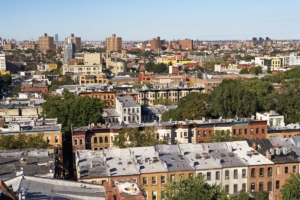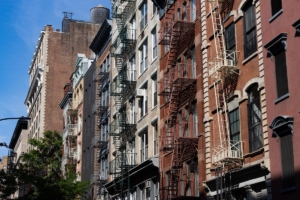
In some places in the city, such as Long Island City, landlords are open to negotiating rent and willing to offer concessions and free perks.
Ahead of peak rental season, apartment shoppers can expect to see slightly higher rent prices than last year, particularly in areas with lower-priced homes, according to StreetEasy’s April 2018 Market Reports[i]. However, those searching for rentals at higher price points and in areas of the city with large quantities of new development are likely to have greater negotiating power.
In Manhattan, rents increased in all submarkets, and rose 0.9 percent borough-wide to $3,159 per month, according to the StreetEasy Manhattan Rent Index[ii]. In Upper Manhattan, where rents are the lowest of any submarket in the borough, rents increased the most: up 3.0 percent to an all-time high of $2,313.
The StreetEasy Rent Index in Brooklyn also rose year-over-year and is up 1.3 percent (or $33) to $2,559. North Brooklyn was the only submarket where rents did not increase; prices there remained unchanged since last year. In Queens, rents declined for the seventh straight month and are down one percent (or $18) since last year to $2,109, driven in large part by large volumes of new construction in Long Island City and Flushing.
“With the city’s economic growth continuing to outpace national growth, demand for affordable homes is pushing up rents at a time when many New Yorkers are thinking about whether to sign new leases or renew their current ones,” said StreetEasy Senior Economist Grant Long. “Even with large amounts of new rental construction, renters should expect rising rents in some of the most affordable pockets of the city, though will still be in a better position amid a generally weak market relative to recent years. Moreover, landlords in parts of the city like Downtown Brooklyn, Long Island City, and Midtown are open to negotiation and willing to offer concessions and free perks.”
April 2018 Key Findings — Manhattan
- Rental discounts rose the most in Midtown. Eighteen percent of apartments in Midtown are offering discounts, an increase of 3.0 percent year-over-year. Rent cuts fell in three submarkets: dropping 1.8 percent in the Upper West Side, 0.4 percent in the Upper East Side and 1.6 percent in Downtown Manhattan.
- Manhattan home prices rose. The StreetEasy Manhattan Price Index[iii] increased 1.0 percent to $1,173,435. After a period of falling prices, the Upper East Side StreetEasy Price Index increased 3.8 percent since last year to $1,059,064.
- Manhattan homes offered the most price cuts. In the borough, 15.5 percent of homes had their prices cut, a 4.6 percent increase over last year.
- Sales inventory rose by double digits. Inventory grew 12.4 percent since last year. The Upper East Side saw the biggest increase: up 14 percent year-over-year.
- Manhattan homes spent longer on the market. The median days on market increased to 61 days in Manhattan – up three days since last year. Homes in Downtown Manhattan spent 67 days on the market – up 12 days since last year. Homes in the Upper West Side spent three less days on the market, as buyers took advantage of previously falling prices and discounts.
April 2018 Key Findings — Brooklyn
- Rents stagnated and discounts rose in North Brooklyn. North Brooklyn was the only submarket that didn’t see a change in rent prices since last year. The StreetEasy North Brooklyn Rent Index remained unchanged since last year at $3,041. Twenty-two percent of rentals in North Brooklyn were discounted, a 4.1 percent increase over last year.
- Prospect Park rentals offered the fewest discounts and tightest inventory. Rents in Prospect Park grew by 1.3 percent since last year to $2,635. Just 12 percent of rentals in Prospect Park had their prices cut – a 2.6 percent annual decrease. Rental inventory dropped the most of any submarket: down 25.7 percent year-over-year.
- Sales prices stagnated. The StreetEasy Brooklyn Price Index remained unchanged since last year at $741,705.
- Sales inventory at an all-time high. Inventory increased 22 percent since last year to a new high.
- Price cuts are up. Compared to last year, 10.8 percent of homes in Brooklyn had their price cut, which is a three percent increase year-over-year. Northwest Brooklyn saw the highest share of price cuts at 13.3 percent.
- Prices rose in North Brooklyn, despite L train shutdown. Prices rose 12.4 percent in North Brooklyn, reaching $1,139,559 and making it the borough’s most expensive submarket. Prices in Northwest Brooklyn fell the most in the borough: down 9.1 percent to $1,097,873.
April 2018 Key Findings — Queens
- Rents dropped across Queens but rose in Central Queens. Rents in Queens dropped 1.0 percent year-over-year to $2,109. In Central Queens, rents rose 2.0 percent over last year to $2,082.
- Sales prices rose across Queens. The StreetEasy Queens Price Index reached $526,113, a 7.0 percent increase over last year. Prices grew the most in Central Queens: up 8.4 percent to $520,353.
- Sales inventory rose across the borough, reaching a new high in Northwest Queens. The amount of homes on the market increased in Queens by 49 percent year-over-year. Central Queens inventory rose by 45.2 percent, while Northwest Queens inventory rose 33.5 percent – reaching a new high.
- The number of homes offering price cuts rose ahead of home shopping season. Nine percent of homes for sale in Queens offered price cuts – a 3.0 percent increase over last year. All submarkets experienced an increase in discounts, with Northwest Queens homes offering the most at 16.2 percent, a 7.3 percent increase year-over-year.
[i] The StreetEasy Market Reports are a monthly overview of the Manhattan and Brooklyn sales and rental markets. Every three months, a quarterly analysis is published. The report data is aggregated from public recorded sales and listings data from real estate brokerages that provide comprehensive coverage of Manhattan and Brooklyn, with most metrics dating back to 1995 in Manhattan and 2005 in Brooklyn. The reports are compiled by the StreetEasy Research team. For more information, visit http://streeteasy.com/blog/market-reports/. StreetEasy tracks data for all five boroughs within New York City, but currently only produces reports for Manhattan and Brooklyn.
[ii] The StreetEasy Rent Indices utilize a similar methodology to the StreetEasy Price Indices and include only valid and verified listings from StreetEasy. By employing a repeat-rentals approach, the indices emphasize the changes in rent on individual properties and not between different sets of properties. Full methodology here: http://streeteasy.com/blog/methodology-price-and-rent-indices/
[iii] The StreetEasy Price Indices track changes in resale prices of condo, co-op, and townhouse units. Each index uses a repeat-sales method of comparing the sales prices of the same properties since January 1995 in Manhattan and January 2007 in Brooklyn and Queens. Given this methodology, each index accurately captures the change in home prices by controlling for the varying composition of homes sold in a given month. Levels of the StreetEasy Price Indices reflect average values of homes on the market. Data on the sale of homes is sourced from the New York City Department of Finance. Full methodology here: http://streeteasy.com/blog/methodology-price-and-rent-indices/
Hey, why not like StreetEasy on Facebook and follow @streeteasy on Instagram?









